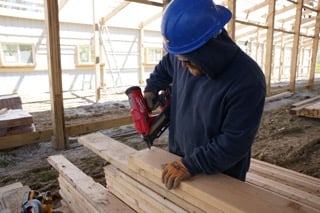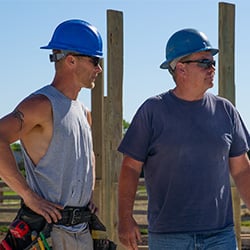How the Big Beautiful Bill Impacts Commercial Construction
Nettie joined the FBi Marketing team in 2022 as the Marketing Content Creator. Nettie grew up just outside of Des Moines, IA. In 2016, she received her BS in Agriculture Communications from Iowa State University. Upon graduation, she has worked in agriculture sales and marketing. She moved to Indiana in 2020. Outside of work, Nettie enjoys quilting, crocheting, crafting, canning, gardening, fishing, and hunting. She is married and enjoys spending time with her husband and dog.
Whether you are a business owner, contractor, land developer, or agent for commercial real estate, you understand that projects often take years to come to fruition. From securing funding to obtaining permits, the process can be lengthy for commercial land developers. By the time the project reaches a general contractor and subcontractors, it can feel like a sudden push to complete the job.
Along with the long initial lead times come uncertainty for developers when taxes, grants, and incentives change. While we may not have a crystal ball to predict the future, we are fairly confident that the recent passage of the Big Beautiful Bill (BBB) on July 4, 2025, will have positive implications for the construction industry in 2026 and beyond.
In this blog, we will explain the six ways the Big Beautiful Bill helps commercial construction and what that might mean for post-frame construction and general contractors in the future.
1. Bonus Depreciation
One of the biggest benefits of the BBB is that bonus depreciation has been made permanent. This allows businesses to deduct a larger portion of certain "short-lived" investments in new or improved technology, equipment, or buildings in the year of purchase.
In addition, the BBB temporarily provides 100 percent of the expenses of qualifying structures, with the beginning of construction occurring after January 19, 2025, and before January 1, 2029, and the structure being placed in service before January 1, 2031.
 Manufacturers also benefit as qualifying production areas within newly constructed facilities are eligible for the same treatment, even though entire buildings typically are not. This is a significant advantage for manufacturing facilities, which could help spur domestic production as tariffs shift supply chains.
Manufacturers also benefit as qualifying production areas within newly constructed facilities are eligible for the same treatment, even though entire buildings typically are not. This is a significant advantage for manufacturing facilities, which could help spur domestic production as tariffs shift supply chains.
This allows landlords across all property types to immediately deduct improvements, such as interior buildouts, lighting, and HVAC, thereby improving profitability and likely spurring additional investment.
2. Section 179
 Section 179 of the IRS code allows business owners to depreciate property. Previously, the maximum deduction was $1.25 million with a 40% deduction of property acquired after September 27, 2017, and placed in service between January 1, 2025, and December 31, 2025.
Section 179 of the IRS code allows business owners to depreciate property. Previously, the maximum deduction was $1.25 million with a 40% deduction of property acquired after September 27, 2017, and placed in service between January 1, 2025, and December 31, 2025.
With the BBB, section 179 expense limits have been increased to $2.5 million, providing small and mid-sized businesses with more flexibility in capital investment decisions.
This means that if you want a larger commercial post-frame building, you can deduct up to $2.5 million of the project!
3. Section 199A
Section 199A allows owners of sole proprietorships, partnerships, S corporations, and some trusts and estates to be eligible for a qualified business income (QBI) deduction.
 This deduction allows eligible taxpayers to deduct:
This deduction allows eligible taxpayers to deduct:
- up to 20% of their QBI
- 20% of qualified real estate investment trust (REIT) dividends
- qualified publicly traded partnership (PTP) income
Many small businesses will rejoice, as the 20% deduction on qualified business income from partnerships, S corporations, and sole proprietorships is now made permanent.
This means that small business owners don't have to worry about this rule going away. Being eligible to deduct 20% of qualified business income allows for more flexibility to invest in future construction projects to grow their business.
4. Energy Tax Changes
If you have been kicking around the idea of adding solar panels to your commercial pole barn project, you must do so before July 4, 2026, to be eligible for tax credits.
 Wind and solar energy tax credits are still available but are phasing out. If your project begins after July 4th of 2026, your facility must be in service by December 31st, 2027 to claim the ITCs and PTCs.
Wind and solar energy tax credits are still available but are phasing out. If your project begins after July 4th of 2026, your facility must be in service by December 31st, 2027 to claim the ITCs and PTCs.
An important note for businesses that may receive manufacturing or renewable energy tax credits: you now need to pay attention to the countries with which you do business. Projects beginning construction after December 31, 2025, are subject to the material assistance from prohibited foreign entities rules.
FEOC "foreign entity of concern" rules that make projects owned or controlled by, or that receive "material assistance" from, a prohibited foreign entity (PFE) ineligible for certain tax credits.
A "prohibited foreign entity" is an entity with ties to China, Russia, North Korea, or Iran.
This means that if you want to claim tax credit for wind or solar, you must start your project immediately and be cautious of the countries from which you source your materials.
5. Research and Development
 Has your company been considering adding to your existing structure? Do you have ideas that need additional research and development?
Has your company been considering adding to your existing structure? Do you have ideas that need additional research and development?
The BBB permanently restores the ability for businesses to immediately deduct domestic research and experimental expenditures, providing critical support for innovation in construction, whether it's hands-on problem-solving that occurs on job sites or improving project delivery methods.
This provision gives business owners and contractors the financial flexibility to invest in finding better, faster, and safer ways to get the job done right, without waiting years to see a tax benefit.
6. Building the Next Generation
 Most business owners understand the struggle of finding qualified and well-equipped help. The trades, in particular, have experienced a labor shortage. To help combat this, the BBB expanded the use of 529 savings accounts to cover career and technical education in the skilled trades, allowing the next generation of construction professionals to enter the workforce without student debt.
Most business owners understand the struggle of finding qualified and well-equipped help. The trades, in particular, have experienced a labor shortage. To help combat this, the BBB expanded the use of 529 savings accounts to cover career and technical education in the skilled trades, allowing the next generation of construction professionals to enter the workforce without student debt.
Even if a young adult doesn't want to pursue a degree in construction, there were additional forgivable loans and changes from the One Big Beautiful Bill Act that impacted the cost of education.
This gives the next generation more financial opportunities to support individuals interested in pursuing a career in the construction field.
How will the Big Beautiful Bill Impact Commercial Construction?
 The Big Beautiful Bill is set to have a significant impact on the commercial building industry in several ways. First and foremost, the bonus depreciation coupled with tax incentives (section 179 & 199A) allows business owners opportunities to make larger capital investments in construction, as the financial incentives provided by the bill can help offset costs for employers.
The Big Beautiful Bill is set to have a significant impact on the commercial building industry in several ways. First and foremost, the bonus depreciation coupled with tax incentives (section 179 & 199A) allows business owners opportunities to make larger capital investments in construction, as the financial incentives provided by the bill can help offset costs for employers.
The additional funding for r&d and vocational education promotes new technology and will help ensure that more individuals are equipped with the skills needed for various trades. This means that businesses will have access to a larger pool of qualified workers, which can help alleviate the labor shortage that has been plaguing the industry, as well as funding to grow their companies and add on to existing structures for future development.
In summary, the Big Beautiful Bill has the potential to transform the commercial construction landscape by addressing labor shortages, promoting infrastructure development, and providing financial support through tax incentives. As these changes take effect, the industry can look forward to opportunities to grow both in new construction projects and business development.
How will the Big Beautiful Bill Impact General Contractors?
For general contractors, new bonus depreciation rules offer a significant advantage by allowing them to write off the cost of new equipment. This provides immediate tax relief and encourages investment in a more modern, efficient fleet.
 Contractors on projects with green energy components, such as solar panels on a post-frame roof, will face new compliance requirements. To secure valuable tax credits, they must obtain affidavits verifying the location of manufacture for the solar panels, as components from certain countries, such as China, may disqualify the project.
Contractors on projects with green energy components, such as solar panels on a post-frame roof, will face new compliance requirements. To secure valuable tax credits, they must obtain affidavits verifying the location of manufacture for the solar panels, as components from certain countries, such as China, may disqualify the project.
Furthermore, changes to education funding, such as 529 savings plans, could have a long-term impact on the labor pool. By making trade schools more affordable, the new rules may encourage more young people to pursue careers in construction, potentially expanding the future number of available subcontractors.
As a general contractor, you can expect a likelihood of more construction activity over the next several years, growth opportunities for your business both in new and different projects, as well as interest from younger people to enter the workforce.
Which Tax Incentive Will You Take Advantage of?
With the Big Beautiful Bill, certain tax incentives were made permanent or extended. This helps alleviate confusion regarding short-term incentives, while also stimulating the economy when individuals have more disposable income and businesses can write off large investments.
Furthermore, this means there should be more construction projects for general contractors in the coming years. With additional funding for schooling, we hope more young people will choose a career in construction as the future looks bright for our industry.
Disclaimer: This information is to inform, but does not provide legal advice. Please consult with your tax representative for what is best for your operation.
Do you have more questions that aren’t covered in this article? If you need help designing and planning, please contact FBi Buildings at 800.552.2981 or click here to email us. If you’re ready for a price, click here to request a quote, and a member of our Customer Engagement Team will help you determine the next steps.


